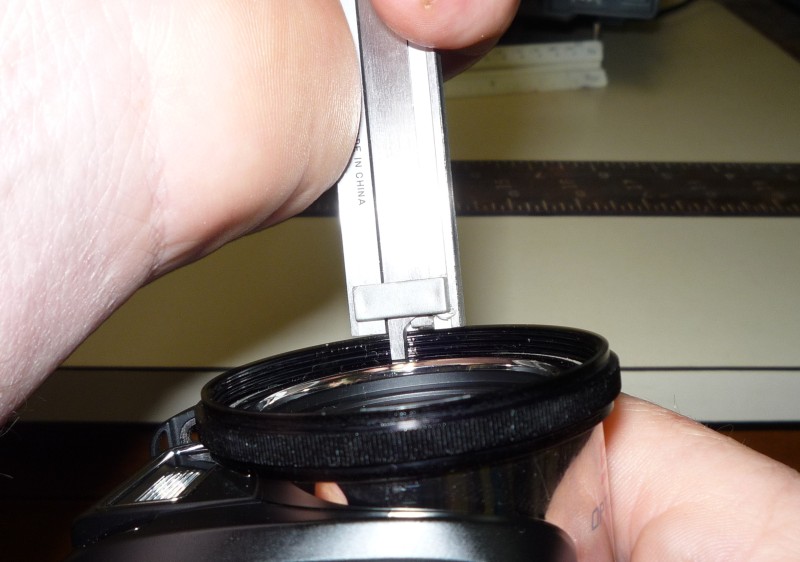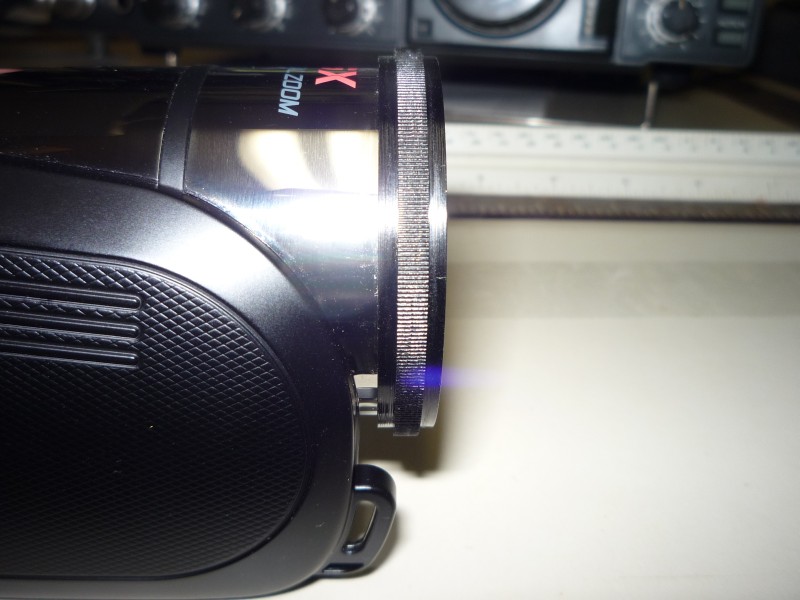if your camera has a round lens barrel, you can probably put a threaded ring on it.
Copyright © 2011 by KV5R. Rev. July 21, 2011
Shop for HD Camcorders here.
The Aiptek H5 Extreme is one of many small digital cameras and camcorders that do not have filter threads on the lens. I’ve seen several YouTube videos where people are gluing or taping step-rings on their cameras, so I though I’d give it a go and try to do it bit better. I measured the outside of the lens barrel at 45 millimeters, then ordered a 46mm female-female coupling ring from camerafilters.com, then mounted that on the camera. I can now mount filters and accessory lenses on the camera just as if it were made that way, and it’s a clean installation that does not modify the camera in any way.
Better in 480p, fullscreen…
About camera filter thread measurements: The nominal size in mm is the outside diameter of the threads—what you will get if you measure a male filter thread with a caliper. The inside diameter of the threads is approximately: outside minus thread pitch, which is either .5 or .75 mm/mm. So a 46mm female thread should be about 45.25mm I.D. This will screw onto the outside of my 45mm Aiptek H5 lens barrel with just three turns of clear packing tape to take up the slack and give the ring something soft to thread into. I cut the tape 1/8th-inch wide and it is completely hidden by the ring, as you will see below.
If your camera has a lens barrel that is nowhere close to a standard filter thread size, you’ll need to make other arrangements, like having a custom piece turned on a precision lathe. Standard sizes are like 37, 46, 52, 55, 58 and upwards. Most palmcorders should be able to use something around 46. The perfect fit would be like this: an aluminum ring with a smooth bore in the back (to fit your lens barrel) and 3-4 tiny set-screws to attach it, and standard female filter threads in the front. But having one custom-made would cost some money!
Some people adapt to the inside of the lens barrel—bad idea. Better to use the outside, and oversize filters and accessory lenses, to avoid problems like vignetting and barrel distortion. Unthreaded consumer cameras are designed to use all of the I.D. of the lens barrel.
Pictures
These are reduced to 800 pixels wide so they fit in a web page.

Here’s the tools and parts. I first tried the aluminum tape, but the threads
just tore and galled it, so I went with the HD packing tape instead.
The threads of the ring should be very lightly greased with Vaseline
so they will impress threads into the tape without cutting it.

The Sonia 46mm female-female coupling ring.

Measure the camera carefully.

Measure the ring carefully.

Use a metal straight-edge and Xacto-knife to cut a 1/8th-inch wide piece of the tape.
Measure and cut carefully.

Wrap the tape around the lens barrel, carefully aligning the tape with the front edge of the barrel.
Wrap in the same direction you will be threading: to the right.

Add or remove tape as need until you can start the ring. When it’s on about one thread,
start measuring and straightening the ring. Get it within .002.

Here’s the ring threaded onto the tape, leaving 3-4 threads exposed.

Looks like it’s made that way! And it’s very tight.

This is the tape I used—it’s quite a bit thicker (~.0025) than the cheap stuff.
It took three turns exactly, which was 16 inches. I started with 24.
Notes
- If you know a gunsmith or watchmaker, you might be able to put tiny, sub-millimeter set-screws in the ring. However, this might distort the ring and make it unusable. And set-screws will mar the finish on your camera.
- Grease the threads of the ring with Vaseline then wipe away all excess. This will help in threading the ring onto the tape without cutting into it and getting tape goo in the threads.
- If you can turn the ring easily, don’t trust it. Add more tape. You don’t want to drop a big fish-eye lens, and you do want to be able to unscrew your filters without the ring turning.
Stay Tuned!
Next, I test the filter ring with some filters, a hood, and a wide-angle/macro lens.
In the works: I’m building a shoulder-mount, walk-around, 20-foot telescoping jib, with a stabilizer on the end, controlled with 4 fishing lines… Imagine that!
After that, I thinking about building another Merlin-style stabilizer using ¼″ 6061-T6 aluminum.
—KV5R
